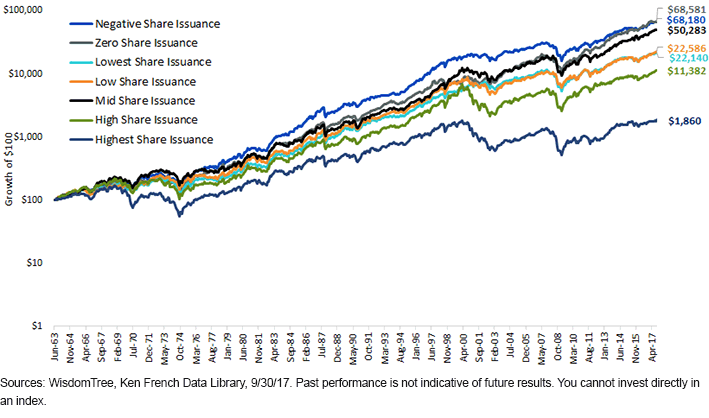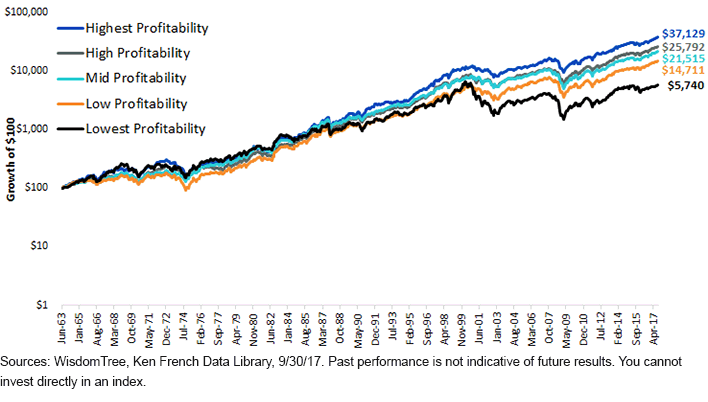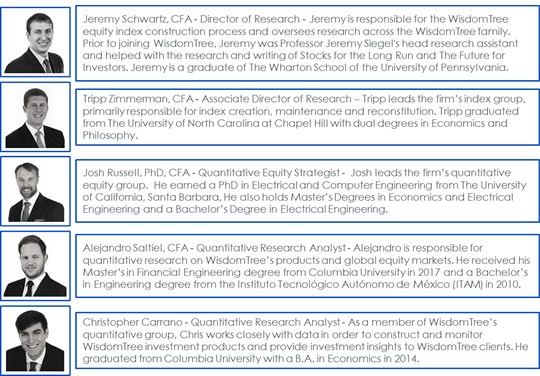Seeking Modern Alpha: Introducing Our New Quantitative Active Strategy, QSY


WisdomTree’s launch of its first 20 exchange-traded funds (ETFs) more than a decade ago was centered on performance. Our original alpha-seeking strategies were packaged into Indexes, but the goals of those Indexes were clear: seek to provide better risk-adjusted total returns than standard market capitalization-weighted benchmarks over the coming decades. Many of these original strategies were built to be very broad-based, relatively low-tracking-error strategies.
Starting with the June 2017 launch of the WisdomTree U.S. Multifactor Index, which was designed to create a diversified set of alpha signals but take more active risk and tracking error, WisdomTree has been pushing out the pursuit for higher potential value-added strategies.
With the repositioning of one of our legacy value strategies (EZY) as our new Quality Shareholder Yield ETF, QSY, WisdomTree has taken the pursuit of modern alpha a step further, running a quantitative active strategy.
Actively Managed: Run Quantitatively with Risk Management Controls
With active management comes a focus on the proverbial five P’s: philosophy, process, portfolio, performance and people.
The philosophy is simple: WisdomTree believes total shareholder yield is one of the premiere valuation guideposts delivering long-term value to portfolio construction, while quality and profitability sorts of the market also provide a sustainability check to these shareholder yield sorts of the market. If you want to invest in companies earning high returns on invested capital, quality sorts of the market accomplish that.
There is a lot of research on buybacks and shareholder yield being tied to performance: Patrick O’Shaughnessy wrote this post on high-conviction buybacks a few years back.
Fama and French added sorts of the market by stock buybacks to their data library, and the long-term returns to high-buyback companies compared to share issuers is fairly dramatic.
Share Issuance Quintiles

Research on quality and profitability as an indicator also shows long-term value added, and WisdomTree believes there are further benefits from combining elements of both of these strategies into a portfolio-selection process.
Operating Profitability Quintiles

Process
The portfolio construction utilizes a quantitative approach to ranking stocks on their combined attributes of quality with minimum shareholder yield requirements.
- We start with a broad universe of large- and mid-capitalization stocks and score stocks on multiple quality criteria—factors such as returns on invested capital and free cash flow-based metrics.
- But we also have a preference for stocks with a minimum shareholder yield, with the portfolio tilting weight toward stocks with the highest-conviction buybacks and highest shareholder yields.
- The portfolio has an equal weighted-like yield orientation to allocating weight—subject to risk controls and overall portfolio balance.
- The portfolio had a primary rebalancing completed in December but will also have adjustments made on a quarterly basis
- Risk controls and portfolio adjustments: The investment model is evaluated for sector and industry tilts and for risk indicators and opportunities in individual stocks. The team has discretion to adjust the portfolio to balance risk and return objectives from the pure quantitative model output.
Portfolio Characteristics
Investors can see the full details of QSY’s holdings every day on our website. The fundamental attributes of the original expected holdings show that this basket of stocks trades at a relatively lower market multiple than the S&P 500 Index, despite the basket having a higher profitability and quality gauge than the S&P 500.
As of the November 30th screening date, these stocks had a net buyback yield over the last 12 months just shy of 5%, and the combined dividend and net buyback yield is close to 7%, approximately 300 basis points (bps) higher than the S&P 500. These are characteristics we believe are long-term powerful drivers of total returns.
People
The team driving the underlying investment process and ongoing research to maintain and enhance the process is the same research team that has been building our equity indexes for more than a decade. Our team has grown from its original days, and we have a more quantitative bent to building out the research team, data collection and investment protocols.

WisdomTree believes combining the quantitative nature that our indexing business was based on with established investment procedures we can utilize in structuring the ETF to leverage our index-based routines creates a unique, modern alpha-oriented approach for active equity ETFs. WisdomTree is excited to be pioneering this stage for actively managed portfolios in the ETF structure.
Important Risks Related to this Article
There are risks associated with investing, including possible loss of principal. Funds focusing their investments on certain sectors may be more vulnerable to any single economic or regulatory development. This may result in greater share price volatility. While the Fund is actively managed, the Fund’s investment process is expected to be heavily dependent on quantitative models, and the models may not perform as intended. Please read the Fund’s prospectus for specific details regarding the Fund’s risk profile.
Click here for QSY standardized performance.

Jeremy Schwartz has served as our Global Chief Investment Officer since November 2021 and leads WisdomTree’s investment strategy team in the construction of WisdomTree’s equity Indexes, quantitative active strategies and multi-asset Model Portfolios. Jeremy joined WisdomTree in May 2005 as a Senior Analyst, adding Deputy Director of Research to his responsibilities in February 2007. He served as Director of Research from October 2008 to October 2018 and as Global Head of Research from November 2018 to November 2021. Before joining WisdomTree, he was a head research assistant for Professor Jeremy Siegel and, in 2022, became his co-author on the sixth edition of the book Stocks for the Long Run. Jeremy is also co-author of the Financial Analysts Journal paper “What Happened to the Original Stocks in the S&P 500?” He received his B.S. in economics from The Wharton School of the University of Pennsylvania and hosts the Wharton Business Radio program Behind the Markets on SiriusXM 132. Jeremy is a member of the CFA Society of Philadelphia.

